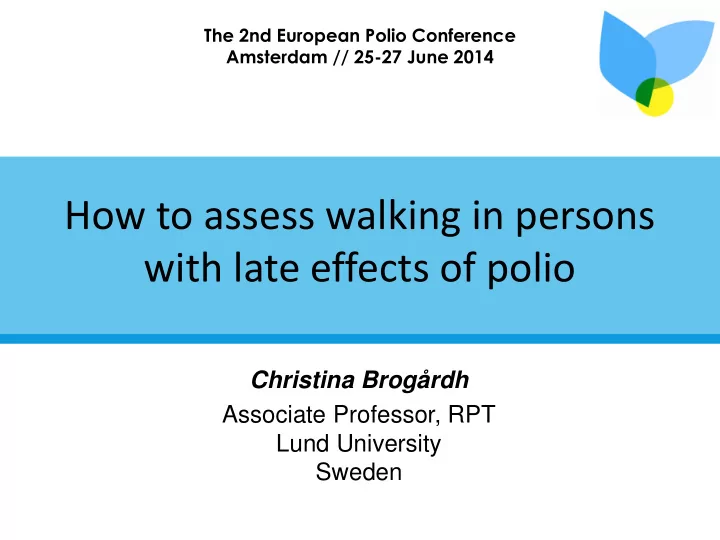

The 2nd European Polio Conference Amsterdam // 25-27 June 2014 How to assess walking in persons with late effects of polio Christina Brogårdh Associate Professor, RPT Lund University Sweden
• One of the most common impairment in persons with late effects pf polio is muscle weakness in the lower limbs, which impedes walking ability • In clinical practice gait performance is often assessed objectively • Self-reported walking ability also important to assess - reflects other dimensions than gait speed and distance
How to assess walking in persons with late effects of polio… • Present 2 studies: – Objectively (4 commonly used tests) – Subjectively (Walking Impact Scale-12)
Reliability of Gait Performance Tests in Individuals With Late Effects of Polio Flansbjer U-B, Lexell J. PM R 2010;2:125-131
• Aim: – to assess the reliability of 4 common gait performance tests in persons with late effects of polio • Method: • Timed Up & Go Test (TUG) • 10 meter walk test (fast and comfortable speed) • 6 Minute Walk test (6MWT)
• Participants: – 30 men and women; mean age 63 years – Ability to walk at least 300 meters • Procedure: – Assessed twice (7 days apart) – Comfortable shoes – Common walking aids
• Test-retest reliability – Intraclass correlation coefficient (ICC2.1) – Mean difference between the two test sessions – Measurement variability • Standard Error of Measurement (SEM%; group of individuals) • Smallest Real Difference (SRD%; single individual)
Results Tests Test sessions 1 Test session 2 Timed Up & Go, sec 10.7 (1.8), 7.1-14.7 10.1 (1.6), 6.1-13.1 Gait speed, sec Comfortable Gait Speed 9.0 (1.6), 6.9-13.5 8.7 (1.3), 6.4-11.5 Fast Gait Speed 6.2 (1.3), 3.4-9.9 6.2 (1.3), 3.6-9.0 6-Minute Walk Test, m 469 (89), 334-699 486 (91), 347-694
Results • Test-retest reliability was high – ICC between 0.82 to 0.97 • Measurements errors generally small – SEM% 4% to 7% (smallest change that represents the real difference for a group of individuals) – SRD% 12% to 21% (smallest real difference for a single individual )
Conclusion • These 4 commonly used gait performance tests are highly reliable • Can be recommended to evaluate various aspects of gait performance in groups of individuals as well as for single individuals in persons with late effects of polio – Evaluate gait speed, distance…
Relationship between self-reported walking ability and objectively assessed gait performance in persons with late effects of polio Brogårdh C, Flansbjer UB, Espelund C and Lexell J. NeuroRehabilitation 33 (2013) 127 – 132
Aim • (i) to assess self-reported walking ability in persons with late effects of polio and • (ii) to determine the relationship between self- reported walking ability and objectively assessed gait performance
Participants • 122 persons with verified late effects of polio – 65 women and 57 men, mean age 65 years – mean time since onset of new symptoms 15 years (SD 8) – all were able to walk independently at least 200 meters • 25% walked with a stick or a rollator • 28% used an AnkleFoot orthosis (AFO) or a Knee- Ankle-Foot Orthosis (KAFO)
Self-reported walking ability • Assessed by the Walking Impact Scale (Walk-12) – 12 items: asks about limitations during the past two weeks in: – walking, running, climbing stairs, standing, distance and effort, need for support indoors and outdoors, concentration and gait quality aspects – Five response options: – from 1 (not at all limited) to 5 (extremely limited) – Sum score reported on a 0-100 scale (%): – 0=no self-perceived limitation and 100=maximum limitation
Gait performance tests • Four objectively gait performance tests: – Timed “Up & Go” test (TUG) – 10 metres Comfortable and Fast Gait Speed tests (CGS and FGS) – 6-Minute Walk test (6MWT) – Reliable in persons with late effects of polio ( Flansbjer U-B, Lexell J. PM R 2010;2:125-131)
Gait performance tests Mean, standard deviation, and minimum (min) and maximum (max) values for Walk-12 and the four gait performance tests in 122 persons with late effects of polio. Outcome measures Mean ± SD Min - Max Walk-12 (%) 51.6 ± 24.7 0 – 100 TUG (seconds) 11.8 ± 4.3 6.9 – 33.2 CGS (seconds) 9.6 ± 2.6 6.4 – 22.0 FGS (seconds) 7.3 ± 2.3 4.2 – 20.3 6MWT (metres) 398 ± 105 150 – 650 TUG= Timed Up & Go, CGS= Comfortable Gait Speed, FGS= Fast Gait Speed, 6MWT= Six Minutes Walk Test.
Relationship between the tests Significant correlations (P <0.01) between Walk-12 and the four gait performance tests (rho -0.66 to 0.63)
Conclusion • The strength of the relationship implies that Walk-12 reflects broader dimensions than the objective gait performance tests • Walk-12 can be a useful tool and a good complement to objective gait tests when walking ability in persons with late effects of polio is evaluated
Thank you!
Recommend
More recommend